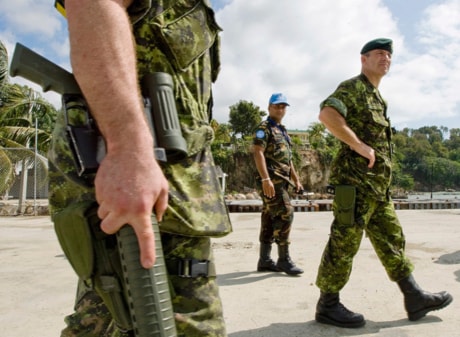PORT-AU-PRINCE, Haiti — The massive international relief effort in Haiti is stumbling over the logistical challenge of coordinating the distribution of emergency supplies as Canada continues to grapple with how and where to contribute its efforts.
But as pallets of water and food sit idle on the tarmac of Port-au-Prince airport, more and more parts of the city slip out of control.
Canadian law enforcement officers serving with the United Nations, most of whom are already several months into their nine-month tours, are growing frustrated at the international community’s inability to get relief to those who need it most.
“There are trucks and trucks just sitting at the airport,” said a Canadian police officer who spoke on the condition of anonymity.
“The water is not getting out.”
The officer said a growing number of neighbourhoods are becoming off-limits as residents erect roadblocks, effectively cutting them off from whatever little authority remains.
Reports circulated Sunday of vigilante-style killings, with bodies being found with their hands tied behind their backs. Authorities fear more than 5,000 criminals have escaped from Haiti’s penitentiaries and are contributing to the instability.
The Canadian military has not been immune to the problems of deploying millions of dollars worth of aid. Despite having well over 100 soldiers in the country, they have been limited to providing medical help at a clinic and perimeter security at the embassy.
Congested airspace above the airport has meant incoming planes must circle for hours before landing, while a shortage of police escorts mean medical supplies have yet to leave the airport.
“So far, the organization has been poor,” the police officer said.
But military sources indicate they are closer to finalizing the area where the bulk of the 1,000 new troops, along with the Disaster Assistance Relief Team, will be deployed.
On Sunday, the head of the incoming task force, Brig. Gen. Guy LaRoche, toured the hard-hit town of Jacmel, southwest of the capital on southern coast.
The UN estimates some 84,000 people were left homeless there by the earthquake, which also destroyed the road to Port-au-Prince.
“These people have a need, that’s for sure, and I think all the support they can get will be welcomed,” Laroche said.
“With the means they have they will never be able to rebuild everything. A lot of people lost families, it’s going to very difficult.”
Soldiers with DART plan to conduct further reconnaissance missions in the Jacmel over the next two days.
“We’re trying to figure out ... the greatest needs,” said Laroche.
To date, the DART company has only deployed its medical contingent. When the engineer contingent arrives they will bring with them a water purification system.
But it could be some time before they are able to start pumping clean water. The military must first decide if it can land Hercules airplanes on Jacmel’s relatively short airstrip.
The military is also debating whether to reroute two warships, the HMCS Athabaskan and the HMCS Halifax, originally headed for Port-au-Prince.
